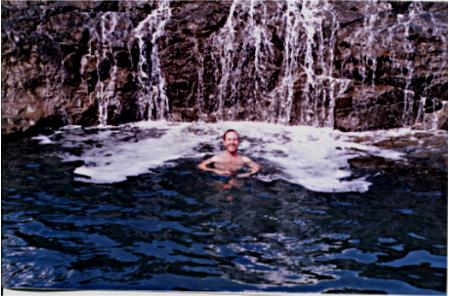Hot Springs and Kitties

06 October 2000, Managua, Nicaragua
Early mornings before sunrise the kittens over my head wake up and start meowing, beating my alarm clock to the punch by thirty minutes. They're the second litter of kittens that's been born and raised on top of my roof since I moved to Managua, and these fuzzy little guys are driving me just as crazy as their predecessors did back in June. But not much else is new in Managua, so I've been escaping weekends and holidays to wander my way through the Nicaraguan countryside in search of a little peace and to remember why I stayed on in Central America.
Before the seasonal rains began to fall in earnest I traveled to a
little fishing town on the Pacific shoreline called El Transito. Over
two years ago a Peace Corps friend of mine had been a volunteer in
that quiet little corner of Central America and had I visited it when
Steve was still there perhaps I'd have seen it with different eyes.
But instead I traveled to the coast with a Nicaraguan family, and was
able to experience El Transito not from my own American point of view
from theirs. The currents were too strong to encourage swimming in
the open Pacific that weekend, but we spent our time instead
scrambling over the rocks looking for crustaceans and taking dips in
the tide pools that fill in behind an enormous volcanic seawall that
runs parallel to the coast. There, instead of striking the beach, the
waves strike the rocks and then thunder up and over them, drenching
you in a frightening roar of sound and a sudden burst of water.

Not long afterwards, Ericka and I took advantage of the two Nicaraguan independence days (celebrating independence first from Spain and then from the short-lived Central American Union) to venture south to Costa Rica. This trip was my third to Costa Rica, but Ericka's first, and again I was fortunate enough to experience the country through the eyes of a Nicaraguan. Although the Costa Ricans are no fans of Nicaraguans their economy is based largely on cheap Nicaraguan labor, and physically the two peoples are indistinguishable from each other. So the Nicaraguans in Costa Rica are everywhere, but they remain unobtrusive. Not until I talked loudly about living in Nicaragua and how much I loved it, could I coax any of them out of hiding. Costa Rica We stayed with Latin American friends of Ericka's in a little apartment painted in the colors of the ocean, venturing downtown to look in the store windows and at the National Museum's collection of pre-Columbus gold figurines. Farther out of town, we visited Volcán Arenal, Central America's most active volcano, which on most nights glows red with lava and hot magma in a frightening reminder of how liquid the earth is beneath our feet. That same evening at the nearby hot springs we unwound from a long day on the bus and watched the moon rise through the clouds.
For the next few weeks my vacationing days are through, as the hurricane Mitch program grows in intensity and my days fill with hydropower dam inspections, road designs, and erosion equations, but I can't complain. Nicaragua is where I want to be for the moment, and if the kitties ever let me sleep in, I'll be content.
Peace and strength,
Randy
Trackbacks
The author does not allow comments to this entry

Comments
Display comments as Linear | Threaded